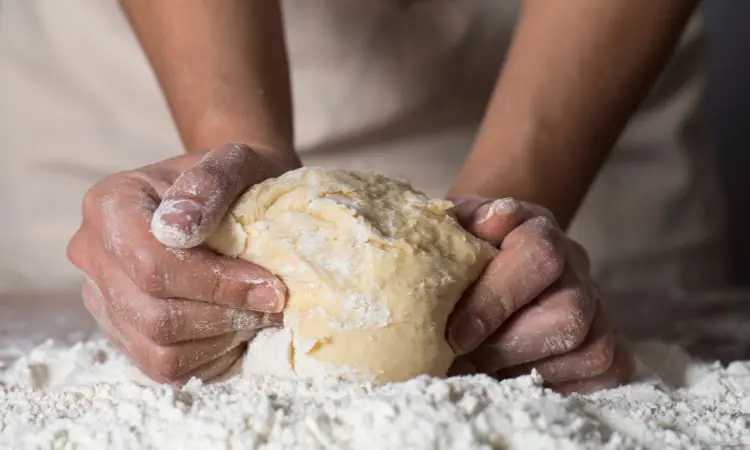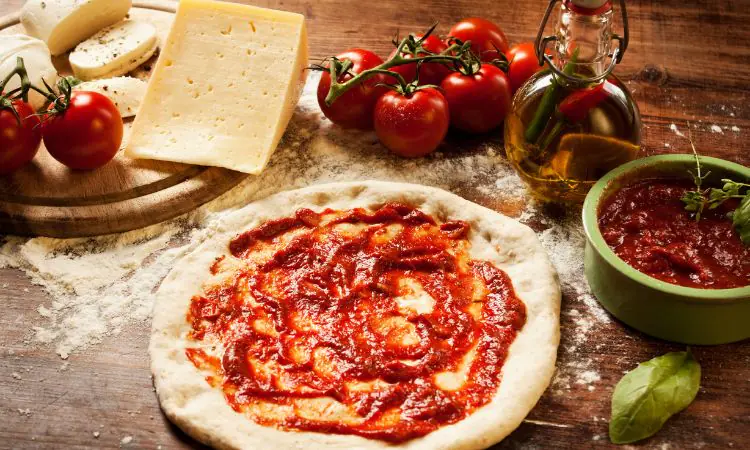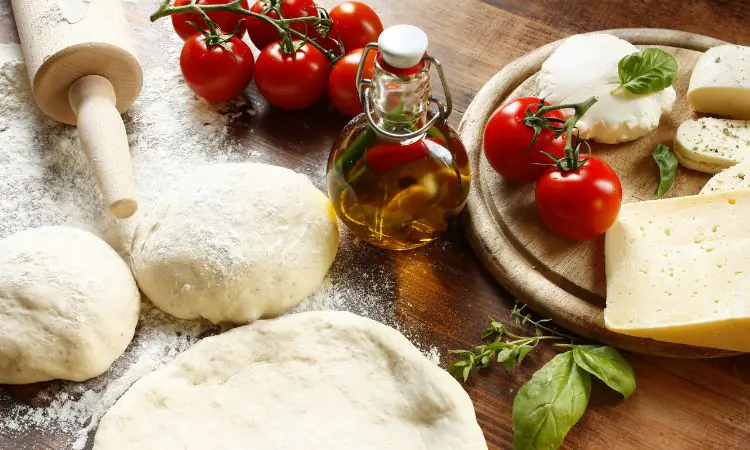Pizza dough is typically softer and more pliable than bread dough, allowing for stretching and tossing. Bread dough, on the other hand, is stiffer and designed to hold its shape during baking.
Discover the world of baking, where the creation of perfect pizzas and bread loaves hinges on the type of dough used. While both pizza dough and bread dough share common ingredients like flour, water, yeast, and salt, critical differences in their proportions and preparation processes set them apart.
Pizza dough aims for a chewy, tender base under the weight of various toppings, hence the importance of a higher hydration level and extensive kneading to develop gluten. In contrast, bread dough often incorporates additional ingredients such as fats for flavor, and it usually undergoes a more structured shaping and proofing to achieve its desired form. Understanding these distinctions ensures that every dough meets its culinary purpose, be it a crust for your favorite toppings or a loaf for your morning toast.

The Basics Of Pizza And Bread Dough
At first glance, pizza dough and bread dough might look the same. They both start as humble mixtures of flour, water, and yeast. Yet, they transform into delicious creations. Each type of dough holds specific traits that shape its texture, taste, and purpose. Let’s knead through the details and find out what sets them apart.
Key Ingredients In Pizza Dough
Pizza dough aims for a chewy yet crisp character. It should support a medley of toppings. Here are its essential ingredients:
- Flour: Usually high-protein, creating a stretchy dough.
- Water: Essential for gluten formation.
- Yeast: Less than bread; provides a slow rise for flavor.
- Salt: Adds strength and controls yeast activity.
- Oil: Often olive; it gives moisture and richness.
Essential Components Of Bread Dough
Bread dough varies from soft and fluffy to dense and hearty. Core ingredients include:
- Flour: Can range from whole grain to white.
- Water: Hydrates the flour; the amount varies.
- Yeast: More than pizza; ensures a robust rise.
- Salt: Balances flavor and fermentation.
- Possibly sugar For flavor and browning.
- Some bread fat: For softness and keeping.

Textural Contrasts: Chewy Vs. Airy
The magical transformation of simple ingredients like flour, water, yeast, and salt into delicious meals lies at the heart of baking. But not all doughs are created equal. A noticeable difference emerges in texture when comparing pizza dough with bread dough. Textural contrasts play a crucial role—pizza crust often boasts a chewy quality while bread basks in its airy softness.
Achieving The Perfect Chew In Pizza
- High-gluten flour: Essential for the elasticity needed in pizza dough.
- Less water Creates a firmer dough, leading to that coveted chewiness.
- Kneading: Develops gluten, contributing to the dough’s structure.
- Longer rise times Allow for gluten networks to strengthen.
Pizza aficionados aim for that signature chew, which provides a satisfying texture. To achieve this, the proper technique and ingredients are crucial. A higher protein content in the flour for pizza dough imparts elasticity—which is vital for withstanding high temperatures without becoming brittle.
Creating An Airy Structure In Bread
- All-purpose or low-gluten flour: Lends to a lighter, softer texture.
- More water Results in a looser dough that rises with ease.
- Stretch and fold techniques: Introduce more air into the dough.
- A gentle touch: Preserves air pockets for a fluffy finished product.
Bread bakers cherish the soft, airy interior encased by a golden crust. This requires a balance of ingredients and gentler handling. The purpose of bread dough is to trap air bubbles, expanding during baking to yield that delightful, light texture often seen in artisanal loaves.
The Science Of Yeast Fermentation
Yeast fermentation is a vital process in baking, transforming the simplest ingredients into delightful bread and pizza crusts. Understanding this process enhances our appreciation for the art of baking. Let’s explore how yeast’s magic works in pizza and bread dough.
Yeast’s Role In Pizza Dough Rise
Pizza dough relies on yeast for its signature texture. Yeast ferments sugar, releasing carbon dioxide gas. This gas gets trapped, causing the dough to rise. The result is a light, airy crust we all love. Here’s how yeast works:
- Activation: Yeast wakes up in warm water and begins to eat.
- Fermentation: It breaks down sugars, creating alcohol and carbon dioxide.
- Expansion: Dough expands with gas bubbles, becoming stretchy.
- Baking: Yeast dies, but the shape stays puffed.
How Yeast Affects Bread Dough Differently
While yeast’s role remains the same, bread dough sees a unique twist. Bread often requires more yeast and longer fermentation. This leads to a dense texture and a pronounced flavor. Factors in bread dough’s unique characteristics include:
| Factor | Effect on Bread Dough |
| Yeast Quantity | More yeast creates a more robust rise. |
| Fermentation Time | More extended periods yield stronger flavors. |
| Texture | A chewier and denser crumb structure. |
| Shape | Structured to support itself when baking. |
Pizza and bread may share common ingredients, but it’s yeast fermentation that genuinely defines their unique characters.
Kneading Techniques Explored
Kneading dough is a crucial step in baking. It mixes ingredients well. It helps dough rise. Knead dough right, and get perfect texture in pizzas and breads.
Kneading For Elastic Pizza Dough
Pizza dough needs flexibility. Elasticity lets dough stretch without tearing. To achieve this, knead the pizza dough for about 10 to 15 minutes. Use a technique that pushes the dough away with the heel of the hand and then folds it back over itself. Use a rhythmic motion. This ensures gluten develops well. A well-developed gluten network gives pizza its signature chewy texture.
Gentle Vs. Intense Kneading For Bread
Every bread type has its kneading needs. Some breads need gentle kneading. Others need a more intense approach. Soft breads, like dinner rolls, often only require gentle kneading. This prevents too much gluten formation, which could make the bread challenging. For chewier breads, like bagels, more intense kneading is critical. This develops a more robust gluten network. A more robust gluten network helps breads like these hold their shape and texture.
| Bread Type | Kneading Time | Kneading Technique |
| Soft Rolls | 5-8 minutes | Gentle |
| Chewy Bagels | 10-20 minutes | Intense |
In conclusion, proper kneading is essential for good texture. Use the correct method and time for each dough. This ensures perfect pizzas and delightful breads every time!
Cooking Methods: Oven Vs. Stone
When it comes to perfecting the art of pizza and bread making, understanding how cooking methods impact the dough is critical. An oven or a stone can lead to very different textures and flavors. Let’s explore the nuances between baking pizza on a stone vs. using a conventional oven for bread.
Baking Pizza: High Heat And Stones
Making mouth-watering pizza involves high temperatures and a good-quality baking stone. Here’s what you should know:
- Quick Cooking: Pizza stones replicate brick ovens, enabling high-heat cooking, which is ideal for a crispy crust.
- Even Heat Distribution: Stones absorb and distribute heat evenly, avoiding soggy centers.
- Better Crust Texture: The porous nature of a pizza stone draws moisture from the dough, ensuring a light and airy crust.
To achieve the best results, preheat the stone at 475–500°F (246–260°C) for about 30 minutes before placing the dough on it.
Traditional Bread Baking Approaches
Bread dough thrives on a gentler and longer baking process compared to pizza dough. The traditional bread-baking methods include:
- Consistent Temperature: Ovens provide a controlled environment, with temperatures usually around 350–475°F (177–246°C).
- Steam: Introducing steam during the initial baking phase helps in forming a glossy crust.
- Longer Baking Times: Bread requires more time to bake, allowing the inside to cook thoroughly without burning the crust.
Use a Dutch oven or a baking pan to support the bread’s shape and retain moisture during the baking process.
Cultural And Historical Perspectives
Pizza and bread both have rich histories in human diets. Different doughs tell unique stories. Each has its place in culture and history.
Pizza Dough’s Italian Heritage
Pizza dough comes from Italy. It’s a cornerstone of Italian cuisine. Its story begins in antiquity. Napoletana pizza is a famous example. It reflects Naples’ spirit. Perfect pizza dough is soft, stretchy, and cooked quickly at high temperatures.
Italian families often pass down recipes. They treat pizza making as an art. They emphasize using simple, quality ingredients.
The Universal Role Of Bread Dough
Bread dough is a global staple. It plays a part in many cultures. In ancient times, bread was a basic food. Different grains create diverse bread types around the world.
Bread dough typically requires yeast. The dough must rise. It gives the bread a soft interior. Crispy crusts are also much loved. Bread baking is less about speed and more about patience.
Each dough has its purpose. Both have evolved. They suit their roles in meals and ceremonies.
| Differences at a Glance | |
| Pizza Dough | Bread Dough |
| Italian roots | Universal presence |
| High-temperature baking | Varied baking conditions |
| Quick preparation | Requires more time |
Let’s cherish these delightful doughs. They give us pizzas and bread. They bring joy to tables worldwide.

Frequently Asked Questions On What Is The Difference Between Pizza Dough And Bread Dough
What Makes Pizza Dough Different From Bread Dough?
Pizza dough is typically made with a higher gluten flour compared to bread dough, which allows it to stretch and creates a chewy texture. Additionally, pizza dough often contains less yeast and is usually allowed to rise for a shorter duration, leading to a denser final product.
Can You Use Pizza Dough To Make Bread?
While pizza dough can be used to bake bread, the result might differ from traditional bread loaves. The bread may have a denser crumb and chewier texture due to the higher gluten content and lower yeast amount in pizza dough compared to bread dough.
Is Bread Dough Healthier Than Pizza Dough?
The healthiness of the dough depends on the ingredients used. Generally, bread dough may have additional fats, sugars, and sometimes eggs, making it richer, whereas pizza dough often has a simple mix of flour, water, yeast, and salt.
Does Pizza Dough Use Different Yeast Than Bread Dough?
Both pizza and bread dough typically use the same type of yeast, often either active dry or instant yeast. However, the quantity and proofing times may vary, affecting the dough’s rise and texture.
Conclusion
Understanding the nuances between pizza dough and bread dough is critical to mastering your baking skills. Each type harbors distinct ingredients and techniques, defining their unique textures and flavors. With this knowledge, you’re now equipped to tailor your dough-making for that perfect loaf or pie.
Embrace the differences and enjoy the delicious results of your culinary creations. Keep experimenting, and happy baking!

As the author of the “Ultimate Pizza Guide: Recipes, Tips & Secrets Revealed,” I’m dedicated to sharing my love for pizza and empowering others to create delicious homemade pizzas with ease. Join me on a journey to uncover the secrets to perfecting your pizza game!


